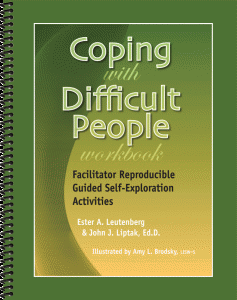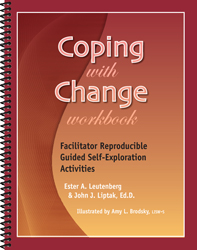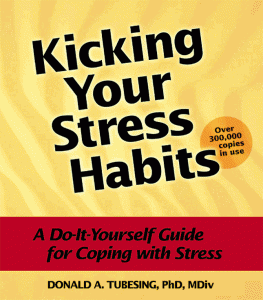Types of Difficult People and How to Deal with Them
Excerpted from Coping with Difficult People
By Ester R.A. Leutenberg and John J. Liptak, PhD
 Difficult people are everywhere. Difficult people are those who frustrate us to no end. (In fact, others may view each of us as a difficult person.) We encounter difficult people at home, in the workplace, school, grocery market, anywhere. Often how much they affect us depends on our self-esteem, ability to recognize “hot buttons” and effectiveness of communication skills. Although one meets many different varieties of difficult people, we have suggested six types that seem to be the most common. These difficult people will have some or all of the following traits:
Difficult people are everywhere. Difficult people are those who frustrate us to no end. (In fact, others may view each of us as a difficult person.) We encounter difficult people at home, in the workplace, school, grocery market, anywhere. Often how much they affect us depends on our self-esteem, ability to recognize “hot buttons” and effectiveness of communication skills. Although one meets many different varieties of difficult people, we have suggested six types that seem to be the most common. These difficult people will have some or all of the following traits:
WHINERS are people who find fault in others and everything they do, blame others for what happens in their lives, and know for certain what should be done but rarely work to improve or correct a situation. They whine in a high-pitched tone, cry and grumble to complain about problems rather than working to fix them or find solutions for them. They are often able to see problems that need solutions, but choose to complain about the problems rather than working to solve them.
KNOW-IT-ALLS are people who think that they know more than everyone else. They believe they have more knowledge and expertise and have all of the answers, and they know they are always right. They do not like to be corrected and will often be impatient, defensive, defiant and sarcastic with people who disagree with them, or they shut down or argue without reason. They feel they are experts on all subjects, behave arrogantly and take exception to anything said to them.
AGGRESSIVE PEOPLE are often angry, impatient and explosive. They use strength, coercion, force, and power to make their point. They often intimidate others into agreeing with them or giving up their point of view. They are critical of people who do not agree with them, and they use ridicule, belligerence, accusations, and verbal, emotional, and/or physical abuse as a way of putting people down. People who interact with them feel a need to be cautious (as if they are walking on eggshells.)
PASSIVE PEOPLE are hard to understand and hard to get to know. They are usually shy, quiet and reserved; they simply want to blend in and not be noticed. They rarely share their opinions or assert themselves to get their views across. They do not talk or share a lot and do not feel the need to respond to questions, especially personal ones. They often appear aloof and detached.
NEGATIVE PEOPLE are usually pessimistic people who will always say such things as “that will never work” and “we have tried that in the past.” They are skeptical that anything will turn out right or be right. They drag others down and make everyone’s environment as negative and as pessimistic as they are. They are unable to see the positive in anything and will always believe that things will not work out.
YES-PEOPLE are super pleasant and agreeable. They usually promise something that they cannot deliver. They seek approval and are afraid to say no to other people, especially the important people in their lives. They say what people want to hear and will agree with each person’s opposing views or opinions.
Here is a model that you can use to build positive relationships with difficult people.
In this model, participants can deal effectively with difficult people in their lives by following a few critical steps including:
- Identify the person’s personality type and what makes the person so difficult for others to handle.
- Learn and utilize critical communication and listening skills to build a positive relationship.
- Cope effectively with the person.
- Learn skills to respond effectively and/or to confront the person.
Sounds simple. Now for some tools to help.
| Interacting with Whiners | |
| Don’t . . .
• agree with the person’s complaints • get defensive • counter-attack • say “You’re such a whiner” • be tough on the person if it’s not their usual style • be sarcastic (“poor poor you”)
|
Do . . .
• listen attentively • ask clarifying questions for precise information • ask “how could it be better?” • create a problem-solving scenario: “What if…” • be supportive • kindly point out the person whining when he/she might not realize it • listen for a bit and then try to solve the problem with the person
|
| Interacting with Know-It-Alls | |
| Don’t . . .
• attack the person’s ideas • put yourself or your ideas down • ask the person cite their source debate • think the person doesn’t know a lot –they might! • try to make the person look bad
|
Do . . .
• listen attentively • respect the person • paraphrase the person’s points • suggest alternatives to the person’s viewpoint • remain neutral throughout your conversations • keep your humor
|
| Interacting with Aggressive People | |
| Don’t . . .
• argue • retaliate • escalate the hostility • fight against the person • try to win the argument • take the behavior personally • submit to their wishes • wait for them to run out of steam
|
Do . . .
• divert attention, if possible • offer information that explains your situation • look for common interests and agreement • remain calm • acknowledge the person’s feelings • explain your feelings using “I” statements • set limits on violence and aggression • walk away if necessary
|
| Interacting with Passive People | |
| Don’t . . .
• fill in the silence with conversation • exclude the person in activities • complete the person’s sentences • talk too much too soon • ask too many questions or appear nosey • exclude the person in conversations • assume the person is disinterested
|
Do . . .
• ask open-ended questions • provide opportunity for the person to speak • wait in silence • be attentive • expect responses • find a topic the person has interest in • be playful, fun loving and friendly
|
| Interacting with Negative People | |
| Don’t . . .
• agree with the complaints • get defensive • counter-attack • think it is a reflection on you • accept blame • spend more time with the person than you need • lose focus on your own energy and positivity
|
Do . . .
• listen attentively • ask clarifying questions for precise information • ask “how could it be better?” • create a problem-solving scenario • be supportive • remain detached • say, “now tell be something positive”
|
| Interacting with Yes-People | |
| • Don’t . . .
• help them out by doing the work they agreed to do, and aren’t doing • get caught up in their need for approval • ask more of them than they can do, even if you know they’ll say yes • let them get you in the middle by saying yes to say yes to someone of a different opinion • give them praise when they say yes, again
|
• Do . . .
• help them turn down activities • be clear about priorities • show them ways to say no • if they do accept a task, help them create a timeline for completion • help them set boundaries • build a relationship and try to talk to them • make suggestions for alternatives
|
For each of these types of negative folks answer the following questions:
The person I know that behaves as a _____________________ is ______________. (It is suggested that you use code names that only you will recognize for this exercise.)
This person behaves_____________________________________________________________
______________________________________________________________________________
______________________________________________________________________________
______________________________________________________________________________
______________________________________________________________________________
My strategy for dealing with this person has been ____________________________________
______________________________________________________________________________
______________________________________________________________________________
______________________________________________________________________________
______________________________________________________________________________
A better way I might deal with this person __________________________________________
______________________________________________________________________________
______________________________________________________________________________
______________________________________________________________________________
A downloadable version of the above is information is available here.




